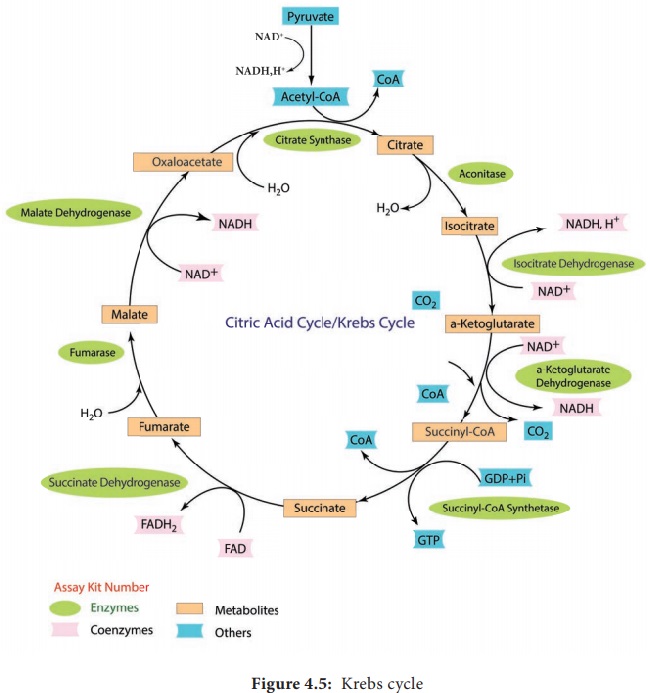Microbial Metabolism | Microbiology - Tricarboxylic Acid Cycle(TCA) | 12th Microbiology : Chapter 4 : Microbial Metabolism
Chapter: 12th Microbiology : Chapter 4 : Microbial Metabolism
Tricarboxylic Acid Cycle(TCA)
Tricarboxylic Acid Cycle(TCA)
TCA cycle
was first elucidated by Sir Hans Adolf Krebs, a German Biochemist in 1937. It
is also known as Tricarboxylic acid cycle, Citric acid cycle or Amphibolic
cycle. In prokaryotic cells, the citric acid cycle occurs in the cytoplasm; in
eukaryotic cells it takes place in the matrix of the mitochondria.

The
process oxidizes glucose derivatives, fatty acids, and amino acids to carbon
dioxide (CO2) through a series of enzyme controlled steps. The
purpose of the Krebs cycle is to collect high energy electrons from these fuels
by oxidizing them, which are transported by activated electron carriers such as
NADH and FADH2 to electron transport chain. The Krebs cycle is also
the source for the precursor of many other molecules and is therefore an
amphibolic pathway (both anabolic and catabolic reactions take place in this
cycle) and therefore, it can be used for both the synthesis and degradation of
bio molecules.
Pyruvate + CoA-SH + NAD+ ←Pyruvate dehydrogenase complex→ Acetyl CoA + Co2 + NADH
Pyruvate
cannot enter the Krebs cycle directly. In a preparatory step, it must lose one
molecule of CO2 and becomes a two-carbon compound. This process is
called decarboxylation. The two-carbon compound, called acetyl group, attaches
to coenzyme A through a high-energy bond, the resulting is a complex known as
acetyl coenzyme (acetyl CoA). During this reaction, pyruvic acid is also
oxidized and NAD+ is reduced to NADH by pyruvate dehydrogenase
complex (PDHC). This multi enzyme complex is responsible for the conversion of
pyruvate to acetyl-coA. Therefore PDHC contribute to linking the Glycolysis
pathway to the citric acid pathway
Pyruvate dehydroge- nase deficiency is a common cause of lactic
acidosis in new born and often present with poor feeding
The Krebs
cycle generates a pool of chemical energy (ATP, NADH, and FADH 2)
from the oxidation of Pyruvic acid and it loses one carbon atom as CO2
and reduces NAD+ to NADH. The resulting two carbon acetyl molecule
is joined to Co enzyme A. Acetyl CoA transfers its acetyl group to a 4C
compound (oxaloactate) to make a 6C compound (Citrate) and the Coenzyme A is
released which goes back to the link reaction to form another molecule of acetyl
CoA. Oxaloacetate is both the first reactant and the product of the metabolic
pathway (creating a loop).
After
citrate has been formed, the cycle machinery continues through seven distinct
enzyme catalyzed reactions that produce in order isocitrate, α – ketoglutarate,
succinyl CoA, succinate, fumarate, malate and oxaloacetate.
At the end of Krebs cycle, each pyruvic acid produces 2 CO2, 1 ATP (substrate level phosphorylation), 3 NADH and 1 FADH2. Then NADH and FADH2 can be oxidized by electron transport chain to provide more ATPs
Related Topics